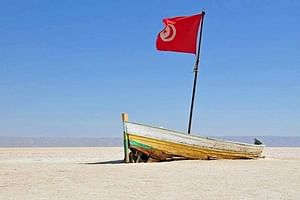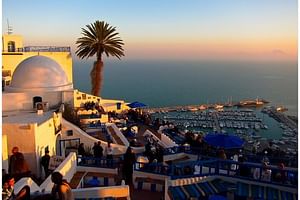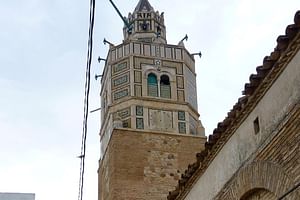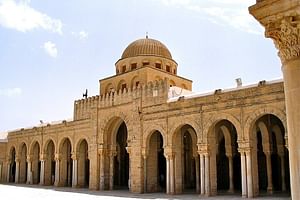-
Day 1
Amphitheater of El Jem Matmata and Ksar Ghilane
Amphitheater of El Jem Matmata and Ksar Ghilane
-
Day 1
The Amphitheater of El Jem is an exceptional testimony to Roman architecture, especially that of monuments built for entertainment purposes, in Africa. Located in a plain in central Tunisia, this amph...
The Amphitheater of El Jem is an exceptional testimony to Roman architecture, especially that of monuments built for entertainment purposes, in Africa. Located in a plain in central Tunisia, this amphitheater, built entirely in freestone, is neither hollowed out nor leaning against a hill. In this, it takes the model of the Colosseum in Rome without however being a simple carbon copy of the Flavian building. Its dimensions (major axis of 148 meters and minor axis of 122 meters) and its capacity (estimated at 35,000 spectators) undoubtedly rank it among the largest amphitheatres in the world.
-
Day 1
The city of MATMATA is located in the south-east of Tunisia, more precisely to the west of the city of Gabès. It is an ancient Berber village stretched out on the hills, identifying with the rocky la...
The city of MATMATA is located in the south-east of Tunisia, more precisely to the west of the city of Gabès. It is an ancient Berber village stretched out on the hills, identifying with the rocky landscapes, with a panoramic view at the top of the mountain and hiding one of the strange sites of Tunisia. The houses of this village are called the troglodyte houses where you can admire the beauty of the underground dwellings in MATMATA. They are located in an underground pit in the form of caves, and each pit (الحوش) takes a circular shape and consists of a courtyard decorated with designs and colors, and it consists of other rooms in the house, the rooms of the house with smooth mud. If you are a history buff, it is recommended to visit this beautiful village, which is visited by tourists from all over the world on daily tours to experience underground life and learn about the customs and traditions of its people.
-
Day 1
KSAR GHUILEN is an oasis in the south of Tunisia located on the eastern limit of the Grand Erg Oriental, and reputed to be the southernmost of the Tunisian oases and one of the gates of the Tunisian S...
KSAR GHUILEN is an oasis in the south of Tunisia located on the eastern limit of the Grand Erg Oriental, and reputed to be the southernmost of the Tunisian oases and one of the gates of the Tunisian Sahara desert, a hot water source outcrops in the 'oasis. This source, in which it is often possible to bathe, would have thermal virtues. Where you will admire a pretty superb Sahara Sunset; and you can, at the same time, take advantage of the Sahara desert by a Quad trip on the sand dunes, camel ride (including in the offer) and a Swimming in the thermal basin of ksar Ghilane . (Included in the offer)
-
Day 1
One night in a guesthouse or similar
One night in a guesthouse or similar
-
Day 2
Tataouine, Ksar Ouled Soltane, Chenini and The island of Djerba.
Tataouine, Ksar Ouled Soltane, Chenini and The island of Djerba.
-
Day 2
TATAOUINE: The governorate of southern Tunisia is one of the most important tourist poles due to the richness of its archaeological and heritage reserves and the environmental and ecological diversity...
TATAOUINE: The governorate of southern Tunisia is one of the most important tourist poles due to the richness of its archaeological and heritage reserves and the environmental and ecological diversity it contains. Tataouine is characterized by the homogeneity of its Berber, Berber and Arab population
-
Day 2
Located about 20 km south of the town of Tataouine in southern Tunisia, the Ksar Ouled Soltane is a very well preserved fortified granary built by the Berbers in the 15th century. Built with adobe (ra...
Located about 20 km south of the town of Tataouine in southern Tunisia, the Ksar Ouled Soltane is a very well preserved fortified granary built by the Berbers in the 15th century. Built with adobe (raw earth), the ksar is spread over two courtyards, each of which has vaulted granaries that serve as food reserves, called ghorfas. In ancient times, granaries were often fortified to stop looters of food reserves in villages. Like other granaries built by Berber communities in North Africa, the Ksar Ouled Soltane is located on a hill, protecting it from these raids.
-
Day 2
Chenini, this Berber-speaking Jewish village in southern Tunisia, 18 kilometers from Tataouine, was established by Berbers and mixed Arabs in a mountainous area, as it was erected on top of a hill. It...
Chenini, this Berber-speaking Jewish village in southern Tunisia, 18 kilometers from Tataouine, was established by Berbers and mixed Arabs in a mountainous area, as it was erected on top of a hill. Its oldest buildings date back to the 12th century. It is distributed over three levels, surmounted by the Chenni Palace, which is a ruined castle that was probably used to store crops such as oil, cereals, spices, etc ... And some buildings are still used to store cereals by the villagers who live in the valley.
-
Day 2
The legend of the Seven Sleepers arouses great devotion in southern Tunisia: the seven saints are venerated in a cave in El Oudiane, in a partially troglodyte mosque in Chenini and in an old cemetery ...
The legend of the Seven Sleepers arouses great devotion in southern Tunisia: the seven saints are venerated in a cave in El Oudiane, in a partially troglodyte mosque in Chenini and in an old cemetery in Midès. It is likely that these sites were already visited in pre-Islamic times, no doubt dedicated to other cults, and that after the Islamization of the region, the predominantly Ibadi local populations maintained the cults rendered at these shrines. It was then gradually the Seven Sleepers who were worshiped there. Among the explanatory hypotheses are the prolongation of the seven-year cults, or the particular memory left in the collective memory and in the toponymy of the sovereign warrior Decius.
-
Day 2
Djerba is an island on the Tunisian coast known for its Mediterranean beaches and white desert towns influenced by Berber, Arab, Jewish and African cultures. Its main city is Houmt Souk. It is famous ...
Djerba is an island on the Tunisian coast known for its Mediterranean beaches and white desert towns influenced by Berber, Arab, Jewish and African cultures. Its main city is Houmt Souk. It is famous for its artisanal markets, its fishing port and its 16th century fortress, Borj el Kebir. To the south is the El Ghriba Synagogue, a place of pilgrimage for the Jews of North Africa.
-
Day 2
4 * hotel in Djerba
4 * hotel in Djerba
-
Day 3
Djerba
Djerba
-
Day 3
The Guellala Museum is an ethnographic museum located in Guellala in Tunisia
The Guellala Museum is an ethnographic museum located in Guellala in Tunisia
-
Day 3
The Ghriba synagogue: is a Tunisian synagogue which constitutes one of the main identity markers of the Jews of Djerba, one of the last living Jewish communities in the Arab world. It is the subject o...
The Ghriba synagogue: is a Tunisian synagogue which constitutes one of the main identity markers of the Jews of Djerba, one of the last living Jewish communities in the Arab world. It is the subject of an annual pilgrimage, on the occasion of the Jewish holiday of Lag Ba'omer, bringing together several thousand pilgrims.
-
Day 3
Djerbahood is an urban art event during which artists from all over the world invest the Tunisian village of Erriadh on the island of Djerba to produce 250 works created for the occasion. It was launc...
Djerbahood is an urban art event during which artists from all over the world invest the Tunisian village of Erriadh on the island of Djerba to produce 250 works created for the occasion. It was launched by Galerie Itinérance de Paris in June 2014.
-
Day 3
Houmt Souk is the administrative capital of the Tunisian island of Djerba. It is located about twenty kilometers from Ajim (point of arrival on the island by ferry) and El Kantara (point of arrival on...
Houmt Souk is the administrative capital of the Tunisian island of Djerba. It is located about twenty kilometers from Ajim (point of arrival on the island by ferry) and El Kantara (point of arrival on the island by the so-called Roman road). It is the main town of the municipality of Djerba-Houmt Souk which is both the capital of a delegation and the seat of a municipality with four districts for 75,904 inhabitants (2014) 2 and covering 176.54 km2 without counting the district of Mezraya. The city of Houmt Souk alone has a population of 44,555 inhabitants in 2004
-
Day 3
4 * hotel in Djerba
4 * hotel in Djerba
-
Day 4
The Return via Gabes
The Return via Gabes
-
Day 4
The Mareth Line was a series of fortifications built by the French to protect their protectorate of Tunisia from an Italian invasion of Libya. During World War II, Rommel re-fortified the Mareth Line ...
The Mareth Line was a series of fortifications built by the French to protect their protectorate of Tunisia from an Italian invasion of Libya. During World War II, Rommel re-fortified the Mareth Line upon his retreat from Egypt after his defeat at El Alamein. The Mareth Line was eventually overwhelmed and Rommel had to continue his retreat. The museum has detailed plans of the battle and some artifacts. Outside there are artillery pieces, bunkers and old trenches.
-
Day 4
Gabès is a city in the south-east of Tunisia.
Largest city in southern Tunisia after Sfax, Gabès has the particularity of being both an oasis and a seaport. This port function dates from industrial ...
Gabès is a city in the south-east of Tunisia.
Largest city in southern Tunisia after Sfax, Gabès has the particularity of being both an oasis and a seaport. This port function dates from industrial development in the 1970s.














